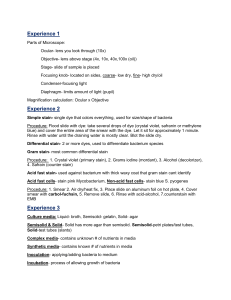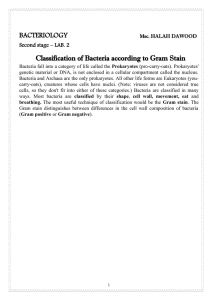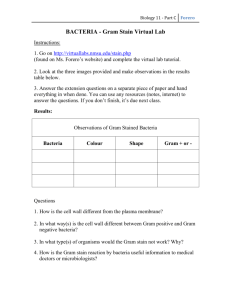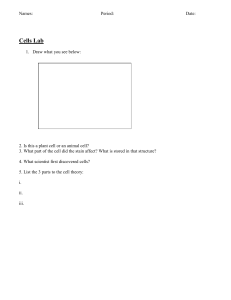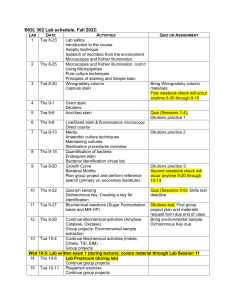Microbiology Lab Techniques: Staining, Culture, and Identification
advertisement
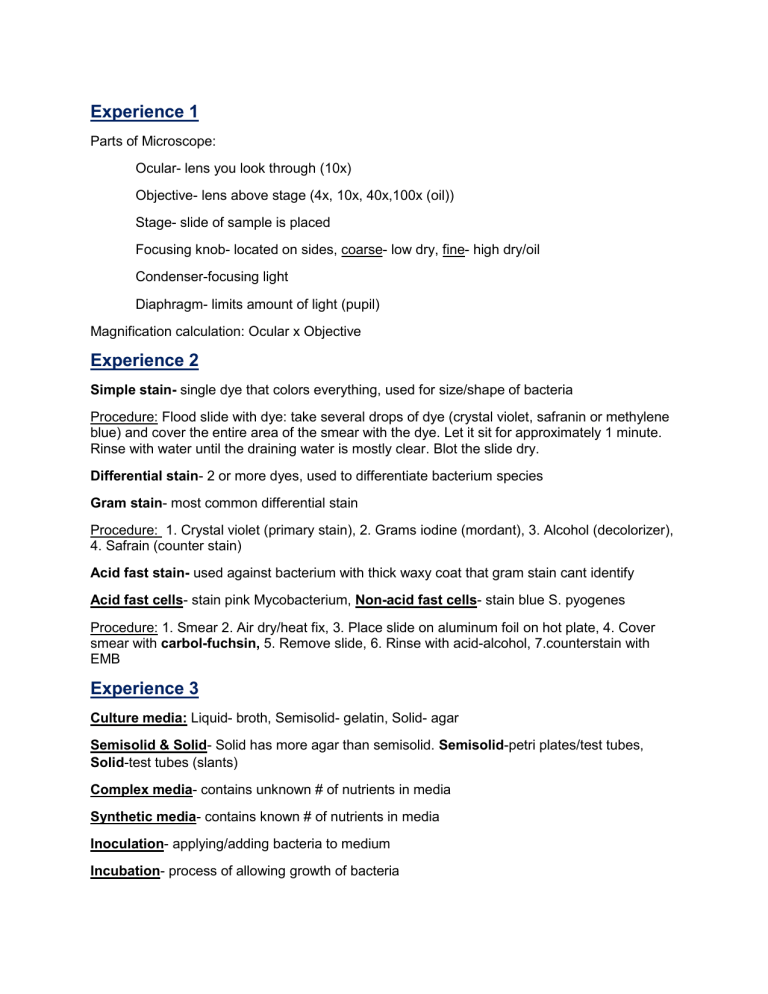
Experience 1 Parts of Microscope: Ocular- lens you look through (10x) Objective- lens above stage (4x, 10x, 40x,100x (oil)) Stage- slide of sample is placed Focusing knob- located on sides, coarse- low dry, fine- high dry/oil Condenser-focusing light Diaphragm- limits amount of light (pupil) Magnification calculation: Ocular x Objective Experience 2 Simple stain- single dye that colors everything, used for size/shape of bacteria Procedure: Flood slide with dye: take several drops of dye (crystal violet, safranin or methylene blue) and cover the entire area of the smear with the dye. Let it sit for approximately 1 minute. Rinse with water until the draining water is mostly clear. Blot the slide dry. Differential stain- 2 or more dyes, used to differentiate bacterium species Gram stain- most common differential stain Procedure: 1. Crystal violet (primary stain), 2. Grams iodine (mordant), 3. Alcohol (decolorizer), 4. Safrain (counter stain) Acid fast stain- used against bacterium with thick waxy coat that gram stain cant identify Acid fast cells- stain pink Mycobacterium, Non-acid fast cells- stain blue S. pyogenes Procedure: 1. Smear 2. Air dry/heat fix, 3. Place slide on aluminum foil on hot plate, 4. Cover smear with carbol-fuchsin, 5. Remove slide, 6. Rinse with acid-alcohol, 7.counterstain with EMB Experience 3 Culture media: Liquid- broth, Semisolid- gelatin, Solid- agar Semisolid & Solid- Solid has more agar than semisolid. Semisolid-petri plates/test tubes, Solid-test tubes (slants) Complex media- contains unknown # of nutrients in media Synthetic media- contains known # of nutrients in media Inoculation- applying/adding bacteria to medium Incubation- process of allowing growth of bacteria Calculating OCD: CFU/ ml, # of colonies counted (CFU) / volume of inoculating loop (ml) Selective: allows only 1 type of bacteria to grow Differential: allows growth of many bacterium Pour Plate Method-Liquid suspension of bacteria added to liquid auger mixed carefully and the entire suspension is then poured into sterile Petri plate Spread Plate Method small amount of liquid suspension of bacteria placed on surface of Agra plate and then carefully spread over surface these two methods are most useful for isolation of pure colonies and for determining # of bacteria present Streak Plate Method can be used with either liquid or solid & is the quickest and easiest method of obtaining a pure culture Urine Streak semi quantitative method of determining an approximate number of bacterial cells in fluids such as urine Experience 4 Enterobacteriaceae: anaerobic, gram – ferment glucose and are oxidase Eosin Methylene Blue (EMB) Agar: Selective medium for gram negative bacteria as well as differential medium for lactose fermentation SIM’s media: Semisolid medium that can be used to test for production of indole the reduction of sulfur and motility + result: black precipitate Indole test: + result: cherry red ring on the top of the medium - result: no color change MR-VP: + result: MR red color VP red-band an upper part of solution - result: MR no color change VP copper colored band Citrate utilization test + result: BLUE - result: GREEN Carbohydrate fermentation test production of gas see if substance can use fermentation of carbs + result: YELLOW - result: RED Enterotube Glucose + result: YELLOW (wax lifted) - result: RED LYS + result: PURPLE - result: YELLOW ORNI + result: PURPLE - result: YELLOW H2S + result: BLACK - result: BEIGE INDOLE + result: RED - result: BEIGE /NO COLOR ADONITOL + result: YELLOW - result: RED LACTOSE + result: YELLOW - result: RED ARABINOSE + result: YELLOW - result: RED SORBITOL + result: YELLOW - result: RED VP + result: RED - result: NO COLOR DULCITOL + result: YELLOW - result: GREEN PA + result: BLACK/GREY - result: GREEN UREA + result: PINK - result: BEIGE CITRATE + result: BLUE - result: GREEN Experience 5 Gram + bacteria include: Staphylococci & Streptococci S. aureus- Scalded skin syndrome skin infections boils toxic shock syndrome food poisoning septic arthritis pneumonia endocarditis S. epidermitis- artificial valve endocarditis catheter an shunt infections prosthetic infection S. saprophyticus- UTI S. pyogenes- pharyngitis, scarlet fever, Toxic shock syndrome skin infections S. agalactiae- pneumonia, meningitis Group D Streptococci Enterococcus- UTI S. pneumoniae- pneumonia, meningitis, sinusitis S. Viridans- dental carries S. mutans Catalase + result: Staphylococcus species clusters - result: Streptococcus species chains Mannitol salt agar+ result: YELLOW = S. aureus - result: PINK= S. Epidermitis Hemolysis of Blood agar Alpha- partial clearing Beta- complete or total clearing Gamma-no clearing CAMP test + result: Large arrowhead shaped hemolytic zone NACL BROTH + result: bubbles, cloudiness Bile Esculin + result: slant medium turns black Sensitive: large clear zone Resistant: no clear zone Intermediate: small clear zone Experience 8 Importance of Fungi: Antibiotics, Food production, Substance production, Food spoilage, Allergies Fungi- eukaryotes Body of fungus- Mycelium Individual strands- hyphae Hyphae have cell walls made of chitlin Fungi reproduce sexually/asexually Asexual- produce large spores, outer covering of spore is called Sporangia, if it is at the end of specialized cells it’s called Conidiophores Asexual spores called- Conidia Experience 10 Epidemiology is the study of the frequency and distribution of disease (pathogens). It allows for development of guidelines for the prevention and control of certain diseases. Some of the videos posted for Experience #10 will show how some infectious diseases are potential epidemics just based on their high infection and transmission rates. Skilled healthcare officials and experienced epidemiologists’ study and plan how to prevent infectious diseases from becoming epidemics. Public Health Microbiology refers to a cross-cutting area that spans the fields of human, animal, food, water, and environmental microbiology, with a focus on human health and disease. Public Health Microbiology Laboratories play a central role in detection, monitoring, outbreak response, and providing scientific evidence to prevent and control infectious diseases. PHM requires laboratory scientists with ability to work effectively across disciplines, particularly with epidemiologists and clinicians. Diseases are spread 8 different ways and the associated diseases with each mode of transmission. 1. Airborne- inhalation of respiratory droplets or particles containing a pathogen Diseases: Measles, Valley fever, COVID-19, Influenza, Anthrax 2. Blood- direct contact with infected blood, blood transfusion, sharing needles Diseases: HIV, Hepatitis, Ebola, Sepsis 3. Direct skin- skin to skin contact with infected individual Diseases: MRSA, Herpes, Athletes foot, Superficial/Cutaneous Mycosis 4. Vectors (insects)- mosquitos Diseases: Malaria, Yellow fever, Lyme disease, Plague, Zika, Encephalitis, West Nile virus 5. Food- eating contaminated food Diseases: Giardiasis, Salmonellosis 6. Water- drinking contaminated water Diseases: Cholera, Giardiasis, Amoebiasis 7. Sex- sexual intercourse through discharges/fluids Diseases: HIV, Chlamydia 8. Animals (Zoonotic)- animals to humans through air (influenza) or bites/saliva (rabies) Diseases: Avian Flu, Ebola, Rabies, Influenza
